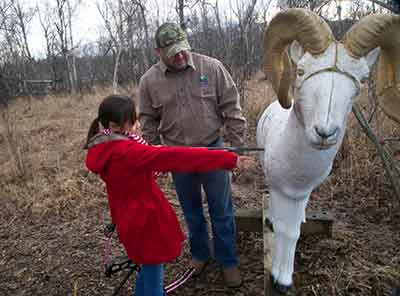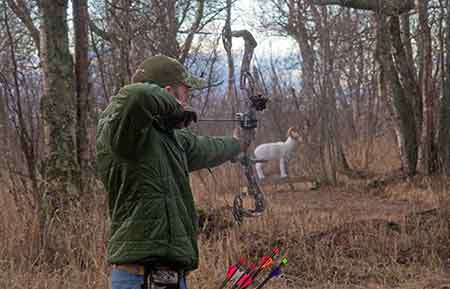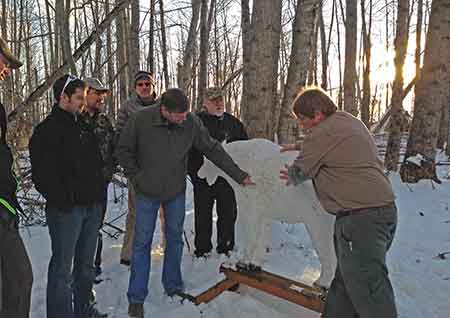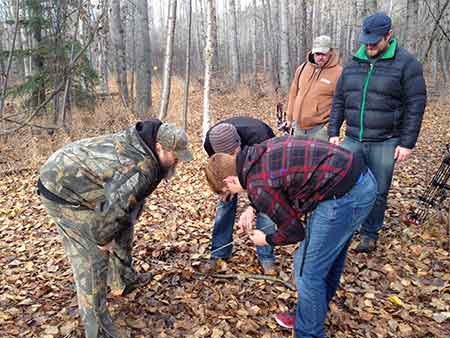Alaska Fish & Wildlife News
April 2016
Bowhunter Education in Alaska

Turns out archery and bowhunting are kind of a big deal in Alaska – and America in general. But no one knew exactly how big until 2013, when the Archery Trade Association conducted its first-ever nationwide survey. Findings from that study revealed that in 2012, some 18.9 million Americans age 18 and older participated in some form of archery and/or bowhunting. And based on archery equipment sales since the survey, the number is increasing every year.
Because Alaska hunting licenses don’t distinguish between hunters who use bows or firearms (both disciplines are covered by the same license) tracking bowhunters specifically is not possible. However, rising interest in bowhunter education courses conducted by the Alaska Department of Fish and Game indicate an upward trend. While this upward trend in bowhunter education certifications suggests an active Alaska bowhunting community, the growing ranks can also be attributed to an important decision by the Alaska Board of Game.
In 2014, the board passed a regulation requiring all big-game hunters (resident and nonresident) using archery equipment to have successfully completed a department-approved bowhunter education certification course, effective July 1, 2016. That regulation was since refined at the board’s statewide meeting in March 2016 by adding an exemption for older, presumably experienced, archery hunters participating in general-season hunts only. Now, to participate in general-season hunts, “a person born after January 1, 1986, using a longbow, recurve bow, or compound bow to hunt big game must have successfully completed a department-approved bowhunter education course.”
That exemption does not apply to participants in archery-only hunts. In archery-only hunts, all bowhunters must have successfully completed a department-approved bowhunter education course to participate.

The following chart illustrates the current regulations simply:
| Type of Hunt | Birthdate | Bowhunter Education |
| General Season | Before January 1, 1986 | Not Required |
| General Season | After January 1, 1986 | Required |
| Restricted weapons hunts (archery-only) | All | Required |
So, what can bowhunters who fall into one of the categories requiring bowhunter education prior to hunting big game in Alaska expect from the department’s certification class? Here’s a brief overview:
Volunteer Instructors
The Hunter Information & Training (HIT) Program administers the National Bowhunter Education Foundation/International Bowhunter Education Program (NBEF/IBEP) bowhunter education course. The HIT Program, with the assistance of more than 400 volunteers, offers three certification courses (hunter education, bowhunter education, and muzzleloader education) and is actively involved in outdoor programs designed to recruit and retain new hunters into the shooting sports and to preserve our hunter heritage. These volunteers are trained and extremely enthusiastic about bowhunting and instructing. Many of our instructors have been volunteering with the HIT Program for 10-plus years, and they love to assist with training new volunteer instructors. To become a volunteer instructor, visit the HIT Program website.

Course Options
The Alaska bowhunter education course can be taken in-person as part of an instructor-led course, or as an online course-plus field day.
Instructor-led course
The instructor-led course typically lasts eight hours. Prior to the course, students must complete the chapter reviews from “Today’s Bowhunter,” included in the packet provided from the Alaska Department of Fish and Game office when you register for the course. The instructor-led course costs $10 and includes a classroom session, written test, blood trailing exercise, and a shooting proficiency.
Online course-plus field day
The online course-plus field day is comprised of two parts. First, students must review the course materials online, complete the chapter reviews, and pass the online written test. The online course costs $30. Upon completion of the online portion of the class, students receive an online field-day qualifier certificate that will allow you to sign up for a field day. The field days typically last four hours and include a short review of Alaska-specific bowhunting topics, a blooding trailing exercise, and a shooting proficiency.

Upon successful completion of all portions of the instructor-led course or the online course-plus field day, students receive their NBEF/IBEP bowhunter education certification, which is valid in all 50 states and for the person’s lifetime.
Proficiency Shoot
The proficiency shoot consists of eight different shooting stations at four 3D animal targets. The student will be asked to shoot from both kneeling and standing positions at targets ranging from 10-30 yards. The proficiency shoot is designed for the student to demonstrate competency with their own archery equipment and that they understand range estimation and the vital zones of big game animals. Students may use range finders and the distances are designed for both traditional and compound bows.
Resources for Non-Residents
Every year thousands of people visit Alaska to hunt, many of them with archery equipment. Every state offers bowhunter education course options so that non-resident hunters can complete their bowhunter education requirement before coming to Alaska to hunt. For more information for each states’ bowhunter education course, here is a document with their course options and website.
HIT Program Contact Information
For more information about the Alaska bowhunter education program, visit the HIT Program website.
Ginamaria Smith is the coordinator of the Hunter Information and Training(HIT) Program at the Alaska Department of Fish & Game. She is an avid archer and bowhunter.
Subscribe to be notified about new issues
Receive a monthly notice about new issues and articles.
